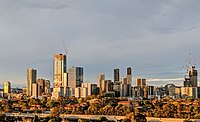| Greater Western Sydney New South Wales | |||||||||||||||
|---|---|---|---|---|---|---|---|---|---|---|---|---|---|---|---|
From top, bottom to right: Parramatta skyline; Suburban neighbourhood in Prestons; Western Sydney Parklands; Stadium Australia; Boothtown Aqueduct; Liverpool at night | |||||||||||||||
 | |||||||||||||||
| State electorate(s) | Several[a] | ||||||||||||||
| Federal division(s) | Blaxland, Chifley, Fowler, Greenway, Hughes, Lindsay, Macarthur, McMahon, Mitchell, Parramatta, Werriwa | ||||||||||||||
| |||||||||||||||
Greater Western Sydney (GWS) is a large region of the metropolitan area of Greater Sydney, New South Wales (NSW), Australia that generally embraces the north-west, south-west, central-west, far western and the Blue Mountains sub-regions within Sydney's metropolitan area and encompasses 11 local government areas: Blacktown, Blue Mountains, Camden, Campbelltown, Cumberland, Fairfield, Hawkesbury, Liverpool, Parramatta, Penrith and Wollondilly.[1] It includes Western Sydney, which has a number of different definitions, although the one consistently used is the region composed of ten local government authorities, most of which are members of the Western Sydney Regional Organisation of Councils (WSROC). The NSW Government's Office of Western Sydney calls the region "Greater Western Sydney".
Radiocarbon dating suggests human activity occurred in the Sydney metropolitan area from around 30,000 years ago.[2] The Darug people lived in the area that was greater western Sydney before European settlement regarded the region as rich in food from the river and forests.[3] Parramatta was founded in 1788, the same year as Sydney, making it the second oldest city in Australia. Opened in 1811, Parramatta Road, which navigates into the heart of greater western Sydney, is one of Sydney's oldest roads and Australia's first highway between two cities – Sydney central business district (CBD) and Parramatta, which is now the sixth largest business district in Australia.[4] Rapid population increase after World War II saw the settlement of many ex-service men and migrants in the greater west, making it one of the most urbanised regions in the country and an area of growing national importance.[5]
Being the third largest economy in Australia, behind Sydney CBD and Melbourne, the region covers 5,800 square kilometres (2,200 sq mi) and is one of the fastest growing populations in Australia, with an estimated resident population of 2,288,554 in 2017.[1] Western Sydney has the most multicultural suburbs in the country with 38% of the population speaking a language other than English at home, and up to 90% in some suburbs.[6] Containing about 9% of Australia's population and 44% of Sydney's population, the people of GWS are predominantly of a working class background, with major employment in the heavy industries and vocational trade.[6]
Encompassing significant areas of national parks, waterways and parklands, agricultural lands, natural bushland and a range of recreational and sporting facilities, the region also largely contains remnants of critically endangered native Cumberland Plain Bushland and World Heritage-listed areas of the Blue Mountains. The Hawkesbury and Nepean River system is Sydney's firsthand water source and the mainstay of the region's agricultural and fishing industries, and is also major recreational area for the inhabitants of GWS.[1] The heritage-listed Warragamba Dam, the primary reservoir for water supply for Sydney, is located in the greater west.[7]
Cite error: There are <ref group=lower-alpha> tags or {{efn}} templates on this page, but the references will not show without a {{reflist|group=lower-alpha}} template or {{notelist}} template (see the help page).
- ^ a b c Dawson, Natalie. "About Greater Western Sydney". www.westernsydney.edu.au. Western Sydney University. Retrieved 6 February 2018.
- ^ Macey, Richard (2007). "Settlers' history rewritten: go back 30,000 years". The Sydney Morning Herald. Retrieved 5 July 2014.
- ^ "Parramatta – New South Wales, Australia".
- ^ Broomham, Rosemary (2001), Vital connections: a history of NSW roads from 1788, Hale & Iremonger in association with the Roads & Traffic Authority, p. 25, ISBN 978-0-86806-703-2
- ^ The Heritage of Australia, Macmillan Company, 1981, p. 2/24.
- ^ a b "Home – WSROC Region". Profile.id.com.au. Retrieved 10 January 2019.
- ^ "Warragamba Emergency Scheme". New South Wales State Heritage Register. Department of Planning & Environment. H01376. Retrieved 2 June 2018.
 Text is licensed by State of New South Wales (Department of Planning and Environment) under CC BY 4.0 licence.
Text is licensed by State of New South Wales (Department of Planning and Environment) under CC BY 4.0 licence.





